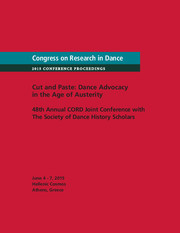Article contents
A Physical Experience While Watching Dance
Published online by Cambridge University Press: 04 January 2013
Abstract
Cognitive neuroscience is an area that helps us to enlarge our knowledge of how movement is perceived and how we can understand the process of kinesthetic empathy. In this article I will analyze the connections between the visual input while watching a dance performance, the motor memory, the awareness of movement sensation, and emotional experiences. Experiments done on monkeys by Rizzolatti et al. gave insight in the working of the brain while watching dance. He discovered activity of neurons, which he called mirror neurons. Many experiments followed by neuroscientists and psychologists like Keysers, Bekkering, and Calvo–Merino. In this article I will use research results from neuroscience, as well as results from my own empirical studies. Those results give us more insight in the mechanisms active in the process of kinesthetic empathy, which can be helpful for choreographers interested in involvement strategies on a movement level.
- Type
- Research Article
- Information
- Congress on Research in Dance Conference Proceedings , Volume 40 , supplement S1: Dance Studies and Global Feminisms , 2008 , pp. 237 - 246
- Copyright
- Copyright © The Author(s) 2008
References
Works Cited
- 1
- Cited by


